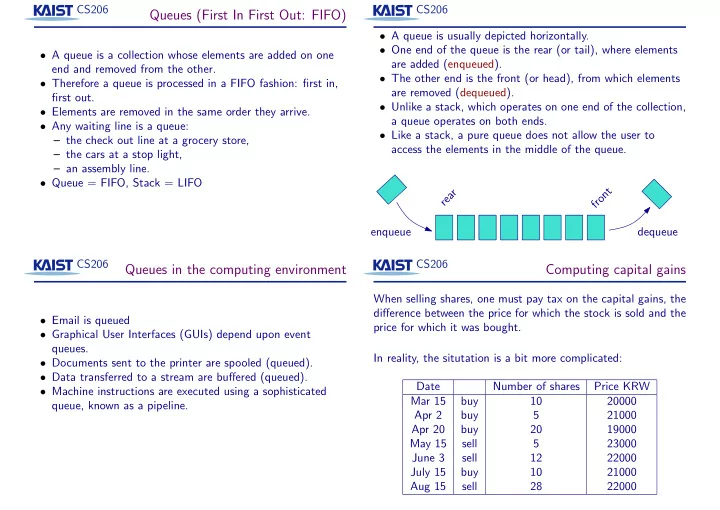

CS206 CS206 Queues (First In First Out: FIFO) • A queue is usually depicted horizontally. • One end of the queue is the rear (or tail), where elements • A queue is a collection whose elements are added on one are added (enqueued). end and removed from the other. • The other end is the front (or head), from which elements • Therefore a queue is processed in a FIFO fashion: first in, are removed (dequeued). first out. • Unlike a stack, which operates on one end of the collection, • Elements are removed in the same order they arrive. a queue operates on both ends. • Any waiting line is a queue: • Like a stack, a pure queue does not allow the user to – the check out line at a grocery store, access the elements in the middle of the queue. – the cars at a stop light, – an assembly line. • Queue = FIFO, Stack = LIFO front rear enqueue dequeue CS206 CS206 Queues in the computing environment Computing capital gains When selling shares, one must pay tax on the capital gains, the difference between the price for which the stock is sold and the • Email is queued price for which it was bought. • Graphical User Interfaces (GUIs) depend upon event queues. In reality, the situtation is a bit more complicated: • Documents sent to the printer are spooled (queued). • Data transferred to a stream are buffered (queued). Date Number of shares Price KRW • Machine instructions are executed using a sophisticated Mar 15 buy 10 20000 queue, known as a pipeline. Apr 2 buy 5 21000 Apr 20 buy 20 19000 May 15 sell 5 23000 June 3 sell 12 22000 July 15 buy 10 21000 Aug 15 sell 28 22000
CS206 CS206 Computing capital gains Implementing a Queue • As a Python list: The standard accounting principe for capital gains valuation is is_empty and front constant time. enqueue constant first-in-first-out (FIFO). time on average. But dequeue takes time linear in the size of the queue! Algorithm: • Can we make a “linked queue” with constant time per • When buying shares, enqueue number of shares and cost. operation, similar to our linkedstack ? • When selling n shares: The problem is that we need to modify the linked structure – Look at oldest shares (front of the queue). Let their on both ends. We’ll look at this later! number be m . – If n < m , then compute profit for n shares based on • Using two Python lists: All operations take constant time price difference. Decrease number of oldest shares. on average. – Otherwise, compute profit for m shares based on price difference. Dequeue oldest shares. Let n ← n − m , and • Can we guarantee constant time per operation if the repeat. maximum queue size is known in advance? CS206 CS206 Circular buffers Circular buffers Implementing a stack using an array is easy—just keep an index to remember the top of the stack inside the array. Empty buffer front rear Implementing a queue is harder, because we insert and remove elements at two different places. The normal way to do this is using a circular buffer. Enqueue one front rear full front Since we do not have circular memory, we have to simulate that Enqueue four front rear using a linear array, and two index dequeue pointers. When the index reaches the end, enqueue Dequeue one front rear it “wraps around” to the beginning. empty rear front Enqueue one rear
CS206 Circular buffers rear front Enqueue three rear front Dequeue two Enqueue three rear front Enqueue one more? rear front What does front == rear mean? Full buffer or empty buffer? Typical solution: Forbid filling buffer completely, always keep one slot free. (See Circular Buffers on Wikipedia for other solutions.)
Recommend
More recommend